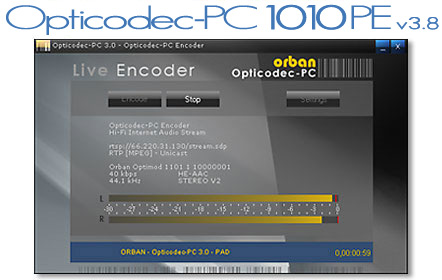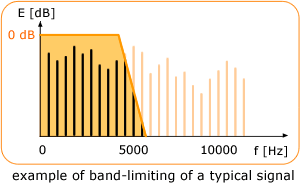
Codec Technology
Opticodec-PC Streaming Audio Encoder uses Coding Technologies AAC/aacPlus codec technology. Now standardized as MPEG-4 High Efficiency AAC (HE AAC), aacPlus is the combination of MPEG AAC and Coding Technologies' SBR (Spectral Band Replication) technology. This combination increases the efficiency of MPEG AAC by up to the factor of two. Accordingly, aacPlus delivers streaming and download 5.1 surround at 128Kbps, CD-quality stereo at 48 kbps and excellent quality stereo at 32 kbps. This level of efficiency fundamentally enables new applications in the markets of mobile, Internet, and digital broadcast.
Coding Technologies' AAC/aacPlus codec technology is now part of the International MPEG-4 Standards. It is an open standard and not a proprietary format unlike other less favorable codec technologies.
MPEG 4 AAC
Ratified MPEG-4 in December 2001
MPEG ISO/IEC 14496-3:2001
MPEG 4 aacPlus v1 = AAC LC + SBR (aka HE AAC)
Ratified MPEG-4 in March 2003
MPEG ISO/IEC 14496-3:2001/AMD-1: Bandwidth Extension
MPEG-4 aacPlus v2 = AAC LC + SBR + PS
Ratified MPEG-4 in June 2004
MPEG ISO/IEC 14496-3:2001/AMD-2: Parametric Coding for High Quality Audio
SBR Explained
What makes Opticodec-PC codecs sound better than other popular codecs?
1. Introduction
Low bitrate audio coding is an enabling technology for a number of applications like digital radio, Internet streaming (netcasting/webcasting) and mobile multimedia applications. The limited overall bandwidth available for these systems makes it necessary to use a low bitrate, highly efficient perceptual audio codec in order to create audio that will attract and hold listeners.
In Internet streaming applications, the connection bandwidth that can be established between the streaming server and the listener's client player application depends on the listener's connection to the Internet. In many cases today, people use analog modems or ISDN lines with a limited datarate — lower than the rate that can produce appealing audio quality with conventional perceptual audio codecs. Moreover, even if consumers connect to the Internet through high bandwidth connections such as xDSL, or CATV, the ever-present congestion on the Internet limits the connection bitrate that can be used without audio dropouts and rebuffering. Furthermore, when netcasters pay for bandwidth by the bit, using a highly efficient perceptual codec at low bitrates can make netcasting profitable for the first time.
In mobile communications, the overall bandwidth available for all services in a certain given geographic area (a network cell) is limited, so the system operator must take measures to allow as many users as possible in that network cell to access mobile communication services in parallel. Highly efficient speech and audio codecs allow operators to use their spectrum most efficiently. Considering the impact that the advent of multimedia services has on the datarate demands in mobile communication systems, it is clear that even with CDMA2000 and UMTS, cellular networks will find it necessary to use perceptual codecs at a relatively low datarate.
2. The Technical Challenge
Using perceptual codecs at low bitrates, however, is not without its downside. State-of-the-art perceptual audio codecs such as AAC, achieve "CD-quality" or "transparent" audio quality at a bitrate of approximately 128 kbps (~ 12:1 compression). Below 128 kbps, the perceived audio quality of most of these codecs begins to degrade significantly. Either the codecs start to reduce the audio bandwidth and to modify the stereo image or they introduce annoying coding artifacts caused by a shortage of bits when they attempt to represent the complete audio bandwidth. Both ways of modifying the perceived sound can be considered unacceptable above a certain level. At 64 kbps for instance, AAC either would offer an audio bandwidth of only ~ 12.5 kHz or introduce a fair amount of coding artifacts. Each of these factors severely affects the listening experience.

3. The Technical Solution
SBR (Spectral Band Replication) is one of the newest audio coding enhancement tools. It can improve the performance of low bitrate audio and speech codecs by either increasing the audio bandwidth at a given bitrate or by improving coding efficiency at a given quality level.
SBR can increase the limited audio bandwidth that a conventional perceptual codec offers at low bitrates so that it equals or exceeds analog FM audio bandwidth (15 kHz). SBR can also improve the performance of narrow-band speech codecs, offering the broadcaster speech-only channels with 12 kHz audio bandwidth used for example in multilingual broadcasting. As most speech codecs are very bandlimited, SBR is important not only for improving speech quality, but also for improving speech intelligibility and speech comprehension. SBR is mainly a post-process, although the encoder performs some pre-processing to guide the decoding process.

From a technical point of view, SBR is a method for highly efficient coding of high frequencies in audio compression algorithms. When used in conjunction with SBR, the underlying coder is only responsible for transmitting the lower part of the spectrum. The higher frequencies are generated by the SBR decoder, which is mainly a post-process following the conventional waveform decoder. Instead of transmitting the spectrum, SBR reconstructs the higher frequencies in the decoder based on an analysis of the lower frequencies transmitted in the underlying coder. To ensure an accurate reconstruction, some guidance information is transmitted in the encoded bitstream at a very low data rate.
The reconstruction is efficient for harmonic as well as for noise-like components and permits proper shaping in both the time and frequency domains. As a result, SBR allows full bandwidth audio coding at very low data rates and offers significantly increased compression efficiency compared to the core coder.
4. The Performance
SBR can enhance the efficiency of perceptual audio codecs by ~ 30% (even more in certain configurations) in the medium to low bitrate range. The exact amount of improvement that SBR can offer also depends on the underlying codec. For instance, when using SBR in conjunction with AAC, we can achieve a quality at 64 kbps stereo that compares to conventional AAC at a bitrate of 128 kbps stereo. SBR can be used with mono and stereo as well as with multichannel audio.
SBR offers maximum efficiency in the bitrate range where the underlying codec itself is able to encode audio signals with an acceptable level of coding artifacts at a limited audio bandwidth.

